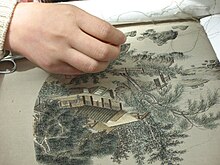Chinese embroidery
The Chinese embroidery is a traditional art of China . It is part of the history of Chinese art and is still an important industry throughout the country. China was the first country to produce silk. Silk embroidery was in great demand outside the Chinese world. Ancient China also produced embroidery on hemp , ramie , cotton, and kudzu fibers . Interest in ancient and modern Chinese embroidery has been renewed since the end of the 20th century. It is mainly characterized by its pictorial motifs. Many symbols imply belonging to a group, including symbols from the empire or the officialdom. For newborns, drawings are chosen that are supposed to serve the traditional defense against evil spirits of the deceased.
history
The earliest finds made in China of a woven side can be traced back to the Neolithic to 6500 BC. To date. The earliest example of silk embroidery discovered in China was found in a tomb from the Zhanguo period (5th – 3rd centuries BC) in Mashan, Hubei Province .
After the opening of the Silk Road in the Han Dynasty (206 BC to 220 AD), silk production and trade flourished. In the 14th century, Chinese silk embroidery reached its peak. Several major silk embroidery styles have been developed, such as Song Jin (锦 锦 Song embroidery) in Suzhou , Yun Jin (锦 锦 Cloud embroidery) in Nanjing, and Shu Jin (蜀锦 Shu embroidery) in Sichuan .
Today handwork has been largely replaced by machines, but some high quality embroidery is still done by hand. Modern Chinese silk embroidery is still very popular, especially in southern China.
Genres
Main styles
Su Xiu (苏绣) - Suzhou embroidery is made in areas around Suzhou in Jiangsu Province and has a history that goes back 2,000 years. Mainly motifs from nature such as flowers and birds, including gardens, are shown in a variety of colors.
A rare variant is the double-sided Su embroidery, which requires ultimate skill and artistry. The ends cannot be knotted, but woven in.
Xiang Xiu (湘绣) - Hunan embroidery originates from areas around Changsha in Hunan Province. It is characterized by a black-white-gray color. The emphasis is on the contrasts of light and shadow that emphasize the pattern texture to create a three-dimensional effect. The Xiang stick composition, like Chinese ink and wash paintings, also design the empty space.
Yue Xiu / Guang Xiu (粤 绣 / 广 秀) - Guangdong embroidery is made in Chaozhou, Guangdong Province. It consists of intricate symmetrical patterns, vivid colors, various stitches and a defined weave. The use of primary colors, light and shadow is reminiscent of western paintings.
Shu Xiu (蜀 绣) - Sichuan embroidery comes from areas around Chengdu, Sichuan Province. It is the oldest known embroidery style in Chinese embroidery history. Its raw materials are satin and colored silk. The focus is on even seams and fine coloring. Sichuan embroidery is used to decorate quilts, pillow cases, clothing, shoes, and painted umbrellas.
More styles
Gu Xiu (顾 绣) - Gu embroidery was created by the Gu Mingshi family in Shanghai during the Ming Dynasty. It is also called Lu Xiang Yuan embroidery after where she lives. She is particularly specialized in painting and calligraphy. The inventor of Gu embroidery was a concubine of Gu Mingshi's first son Gu Huihai. Later on, Han Ximeng, the wife of Gu Mingshi's second grandson, further developed Gu embroidery. Some of their masterpieces are kept in the Forbidden City .
Ethnic styles
Other Chinese ethnic groups, such as the Bai , Miao , Zhuang and Tibetans , have developed their own style of embroidery, often with mythical or religious themes.
Web links
Individual evidence
- ^ Claudine Delecourt: Costumes et textiles d'Asie. Ouvrage collectif. Paris, Skira, 2001. ISBN 88-8491-021-8
- ↑ Danielle Elisseeff: Histoire de l'art: De la Chine des Song (960) à la fin de l'Empire (1912). Paris, edition of the National Museum (Manuals Ecole du Louvre), 2010. ISBN 978-2-7118-5520-9
- ↑ Monique Crick 2004, p. 21 sq. Article de Antoine Gournay Le vêtement en Chine sous la Qing dynastie, p. 27 sq. et notices 17, sq.
- ^ Aurélie Samuel 2010, p. 58 sq. Article de Pauline Le Moigne, "La fonction prophylactique du costume d'enfant en Chine", p. 96 sq.
- ↑ Archaeologists discover the oldest silk remains. In: scinexx.de. Retrieved January 3, 2017 .
